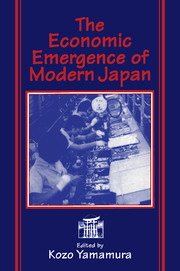Book contents
- Frontmatter
- Contents
- Preface
- 1 Economic change in the nineteenth century
- 2 Industrialization and technological change, 1885–1920
- 3 Depression, recovery, and war, 1920–1945
- 4 The postwar Japanese economy, 1945–1973
- 5 Capital formation in Japan
- 6 Factory labour and the industrial revolution in Japan
- 7 Entrepreneurship, ownership, and management in Japan
- Bibliography
- Index
6 - Factory labour and the industrial revolution in Japan
Published online by Cambridge University Press: 04 August 2010
- Frontmatter
- Contents
- Preface
- 1 Economic change in the nineteenth century
- 2 Industrialization and technological change, 1885–1920
- 3 Depression, recovery, and war, 1920–1945
- 4 The postwar Japanese economy, 1945–1973
- 5 Capital formation in Japan
- 6 Factory labour and the industrial revolution in Japan
- 7 Entrepreneurship, ownership, and management in Japan
- Bibliography
- Index
Summary
INTRODUCTION
An industrial revolution transforms a traditional society into an industrial one. The primary agent in this process is the factory system, which organizes capital and labour on a scale unheard of in traditional society, on the basis of technology and behaviour that are difficult for ‘traditional man’ to understand. By the logic of traditional social organization and according to the outlook of traditional man, the human dimension of a typical work place under the factory system is mysterious and fearsome: that is, a large number of workers, far exceeding the population of a typical traditional village, are organized into a work force in which tasks follow the dictates of the technologically determined division of labour but hang together at the same time in an interdependent framework administered by management. In other words, workers are divided and ruled by managers who derive their authority from technology and the market. Whether this new social structure, though limited to the workplace, is a boon or peril to traditional man depends very much upon the style and pace of industrialization. Eventually traditional man is transformed into ‘industrial man’, as he sheds the traditional outlook and work habits and acquires new personal qualities that enable him to manoeuvre rationally in the class structure of an industrial society. These concurrent transformations, societal and personal, are often fraught with lags and frictions requiring facilitating or regulatory interventions by the state. This chapter sets out to trace these developments in the course of Japanese industrialization.
- Type
- Chapter
- Information
- The Economic Emergence of Modern Japan , pp. 239 - 293Publisher: Cambridge University PressPrint publication year: 1997
- 5
- Cited by



